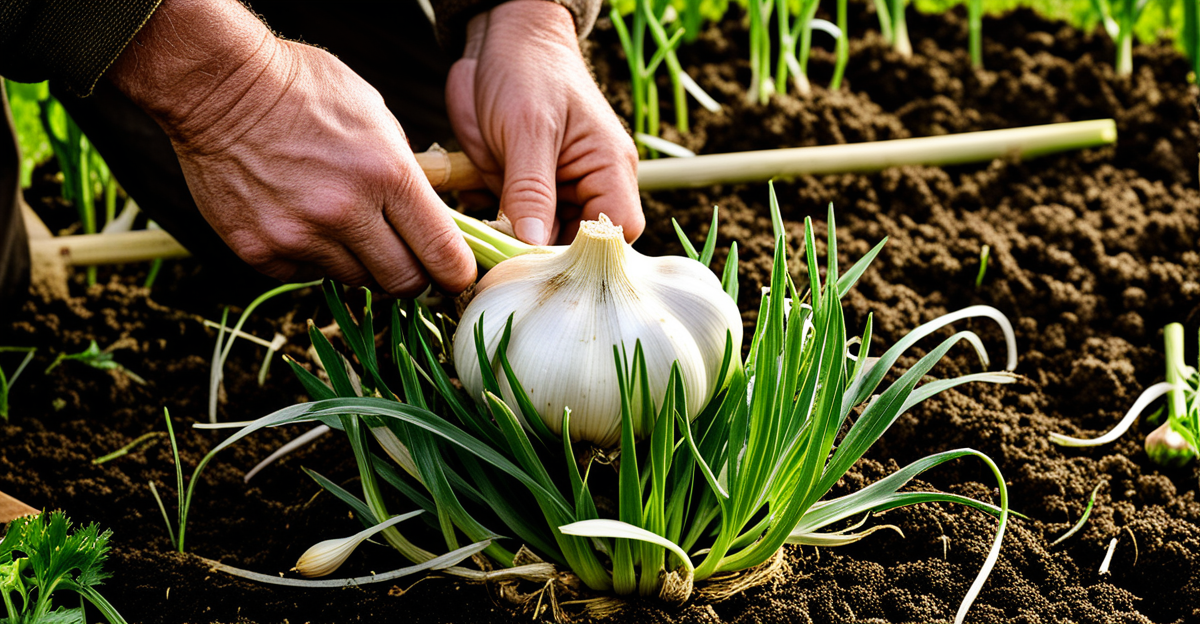Essential Preparation for Successful Garlic Cultivation in the UK
Preparing for garlic cultivation UK begins with selecting varieties that thrive in Britain’s climate. Choose from hardneck types like Rocambole or softneck varieties such as Silverskin, which handle the UK’s cool winters and variable rainfall well. This is crucial for ensuring strong, productive crops.
Soil preparation is equally important. Garlic grows best in well-drained, fertile soil rich in organic matter. Conduct a soil test to assess pH—optimal garlic growth occurs between 6.0 and 7.0. Amend soil with compost or well-rotted manure to improve fertility and structure. Avoid waterlogged or heavy clay soils to prevent bulb rot.
Have you seen this : Choose the right camouflage netting for any event
Understanding crop rotation plays a vital role in sustainable garlic growing preparation. Avoid planting garlic in the same spot more than once every three years. Rotate with unrelated crops like beans or leafy vegetables to reduce disease risk and maintain soil health.
Selecting the right site involves choosing a sunny, sheltered location with good airflow to reduce fungal disease. The combination of proper variety selection, soil preparation, and thoughtful crop rotation forms the foundation of a successful garlic harvest in the UK. This precise approach to garlic cultivation UK is highlighted consistently in UK gardening guides for best results.
Additional reading : Transform your london hideaway into a charming victorian garden with must-have greenery
Step-by-Step Planting Methods for UK Gardeners
Mastering optimal timing and technique for garlic success
The garlic planting guide UK emphasises planting cloves at the precise time for robust growth. When is the best time to plant garlic in the UK? Typically, late autumn (October to November) is ideal, allowing cloves to establish roots before winter. This timing aligns with the UK gardening calendar, ensuring the crop benefits from dormant cold exposure which stimulates vigorous spring growth.
How should seed garlic be prepared? Select large, healthy cloves from certified disease-free bulbs. Separate them carefully without damaging the basal plate. Treating cloves with a mild fungicide or natural antiseptic can reduce fungal risks. Proper spacing is crucial: plant cloves 10–15 cm apart in drills spaced 30 cm apart. This spacing promotes healthy bulb development and airflow.
What are effective planting techniques? Insert cloves upright, basal plate down, about 5 cm deep into well-prepared soil. Cover with soil and mulch to conserve moisture and protect against frost. Consistent depth and orientation avoid uneven growth and reduce pest vulnerability. This detailed planting garlic strategy is widely recommended in respected UK gardening guides to maximise yield and bulb quality.
Nurturing Garlic Crops: Care and Maintenance Strategies
Optimising growth through attentive care
Effective garlic crop care hinges on consistent watering, feeding, and mulching. How should watering garlic be managed? Garlic requires about 1 inch of water per week during active growth, especially in dry spells. Overwatering risks bulb rot, while under-watering stresses plants, reducing size. Mulching with straw or leaf mould helps retain soil moisture, regulate temperature, and suppress weeds, all vital for robust garlic development.
Feeding garlic benefits from balanced, nitrogen-rich fertilisers early in the season to encourage green growth, switching to potassium and phosphorus as bulbs form. Organic options like well-rotted manure or seaweed extracts align well with sustainable vegetable gardening principles.
What about pest and disease prevention? Employing organic methods such as neem oil sprays or encouraging beneficial insects controls common garlic pests like onion fly larvae. Crop rotation complements disease prevention, reducing fungal and viral outbreaks. Weeding is crucial since competing plants deprive garlic of nutrients and air circulation. Companion planting with herbs like chamomile or coriander further supports pest resistance.
Overall, applying these garlic crop care tactics optimises plant health and bulb quality, making the investment of time and effort worthwhile according to respected UK gardening guides focused on sustainable practices.
Proven Expert Strategies for High-Yield, Sustainable Garlic Crops
Achieving high yield garlic crops requires focused strategies grounded in expert advice tailored to UK conditions. A cornerstone is enhancing soil health, which supports vigorous growth and robust bulb formation. Experts recommend regular addition of organic matter like compost or well-rotted manure to boost nutrient availability and microbial activity. This aligns well with sustainable gardening UK principles, which emphasise natural fertility over synthetic inputs.
Crop rotation remains essential for managing soilborne diseases and maintaining soil vitality. Rotate garlic with legumes or leafy greens to break pest and pathogen cycles, ensuring sustainability. Such rotation enhances long-term productivity, critical for expert garlic tips aimed at consistent harvests.
Incorporating local knowledge also enriches practices. For instance, adjusting planting dates based on microclimate nuances can optimise growth windows, reducing stress on plants for better yields. Using disease-resistant varieties further supports sustainable success.
Balanced feeding regimes, favouring organic fertilisers high in potassium and phosphorus during bulb development, boost size and flavour—key targets for high yield garlic producers. Together, these expert strategies form a holistic approach, empowering gardeners to sustainably maximise garlic quality and quantity in UK gardens.
Recognising Signs and Timing for a Successful Garlic Harvest
Harvesting success starts with keen observation and proper timing
When is garlic ready to harvest in the UK? The key sign is when about 50-70% of the leaves have turned brown and begun to dry out, typically occurring from late June to mid-July. This indicates the bulbs have matured beneath the soil.
How do you harvest effectively? Using a fork or spade, carefully lift the bulbs to avoid damaging their skins, which preserves storage life. After lifting, do not wash the bulbs; instead, gently brush off excess soil.
What comes next after lifting? Drying, or curing, is essential. Hang the bulbs in a warm, dry, and well-ventilated space out of direct sunlight for two to three weeks. Proper curing enhances flavour and prevents fungal rot.
For storage, keep garlic in mesh bags or braid softneck varieties, storing them in a cool, dark, and dry environment. Avoid refrigerators, which can prompt premature sprouting.
This precise timing and careful handling in the garlic harvesting UK process are emphasised repeatedly in respected UK gardening guides as crucial for maintaining garlic maturity and achieving the best harvesting techniques outcomes.
Troubleshooting Common Garlic Growing Challenges
Solutions to keep your garlic thriving under UK conditions
What are the typical garlic problems UK gardeners encounter? Common issues include yellowing leaves, which often signal nutrient deficiencies or overwatering, and poor bulb formation caused by insufficient spacing or inconsistent watering. Pests like onion flies and diseases such as white rot also frequently affect UK crops.
How can you identify garlic diseases early? Symptoms like leaf discoloration, wilting, or bulb softness point to fungal or viral infections. White rot shows as whitish fungal growth at the bulb base, while basal plate rot causes shriveling. Early detection via regular plant inspections is crucial for control.
What are effective methods for troubleshooting garlic growth problems? Correcting soil moisture—avoiding waterlogged or dry conditions—is fundamental. Applying organic fungicides or neem oil combats fungal pests. Removing affected plants promptly prevents spread. Improving crop rotation breaks pest cycles, reducing recurring issues.
To recover struggling garlic for future seasons, amend soil with organic matter and test pH to ensure optimal conditions. Adjust planting techniques—like spacing and timing—can alleviate stress factors. Consulting a trusted UK gardening guide offers tailored advice based on local conditions.
These proactive steps address garlic problems UK gardeners face, helping safeguard crops and enhance future yields.











